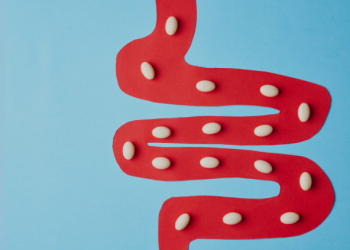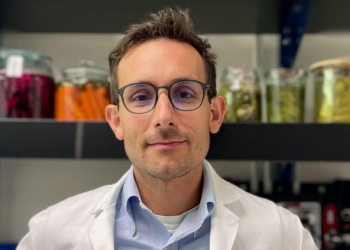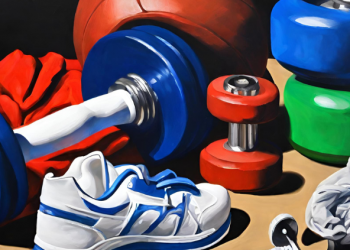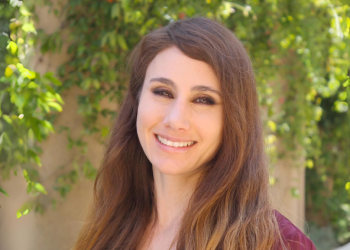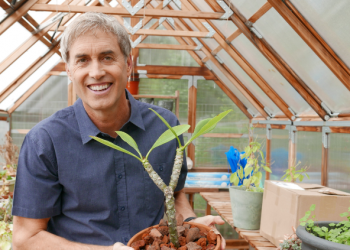Leading Behavior Scientist BJ Fogg, PhD: Not Your Traditional Academic

This blog is part of our Nutrition newsletter. If you like this content, sign up to receive our monthly newsletter!
It was the year 1978 in Fresno, California. A vivacious 15-year-old BJ Fogg biked home after school to put on his white lab coat, pick up his clipboard, and start knocking on doors in his suburban neighborhood.
Knock, knock. “Hello! I’m BJ Fogg,” he said with a big smile. “Usually contact lenses cost $250, but I can sell them to you for just 40 bucks a lens!” Although the typical response was a quizzical look followed by, “Um, no, thank you,” he knew his offer was unbeatable. So he kept on knocking.
BJ Fogg grew up in a Mormon household and is the third of seven children. His father was an ophthalmologist (hence, the contact lens hook-up) and promoted an entrepreneurial mindset among his progeny. From selling cookies or oranges, to washing cars or windows, Fogg and his siblings launched a new small business every summer starting in his elementary school years. These experiences taught him how to think innovatively, take risks and uncertainty in stride, and, most importantly, be resilient and persevere after failure—all attributes that served Fogg well in his illustrious career.
“We had so much fun, and we learned a lot, and I became very comfortable making mistakes,” says Fogg. “I had some pretty notable failures at a young age that seemed crushing at the time, but I just realized, ‘the world goes on.’ You go to bed, wake up the next morning, and move on. Because of these experiences, I became less afraid of failure, which served me later in life.”
Discovering Purpose
After high school, Fogg spent two years as a Mormon missionary in southern Peru. Not only did he run local congregations at age 19, he also offered health education and strategies for locals to stop smoking and drinking—an experience that piqued his interest in behavior change.
“I loved seeing the world in a whole different way. For a while I lived in the remote Peruvian rainforest and didn’t always have running water. I grew a lot during this time,” says Fogg. “In the Mormon culture, being of service is important, and this part of my life inspired me always to ask the question, ‘How can I help people?’”
Fogg attended Brigham Young University (BYU), earning undergraduate and master’s degrees. After graduate school, Fogg lived in France for a summer, intensively studying the French language and Aristotle’s book, Rhetoric, which opened his eyes to the discipline of persuasive communication. During this time, in the early 1990s, he had the novel insight that technology would be used to persuade human behavior in the future, and he decided to pursue this concept in his doctoral studies.
Stanford as a Safe Place
Fogg came to Stanford in 1993 to earn a PhD in Communication Research and began conducting experiments to explore the influence of technology on human beliefs and behavior. Additionally, events that occurred at Stanford at that time impacted Fogg on a personal level.
“As a young man at BYU, slowly realizing I was gay, I felt very alone and afraid,” says Fogg. “Somehow, I felt that if anyone discovered, I would be kicked out of the University, and then my academic career would be ruined.”
During Fogg’s first year as a doctoral student, Stanford football players vandalized the gay liberation statue on campus. Fogg wasn’t fully “out” at that time and sat quietly while listening to his professors (all older, straight men) denounce the football players’ actions.
“I was stunned. I could not have imagined that these professors, who didn’t know me or who I was, would take such a strong public stance to defend gay people,” says Fogg. “That day I had an overwhelming feeling and realization–I am safe here. Stanford is the first place I felt safe and accepted as an adult.”
Not Your Traditional Academic
Since that first year, Fogg has considered Stanford his “home.” After earning his PhD, he became a Consulting Assistant Professor and began teaching for the Computer Science department. In 2000, he started a research lab, where he worked with students investigating how computers influence attitudes and behaviors. In 2002, Fogg published his first book, Persuasive Technology: Using Computers to Change What We Think and Do, which explains how technology has the potential to promote positive change in health and well-being.
Fogg has served in various positions as a teacher and researcher at Stanford, but he never lost his entrepreneurial spirit. As a child, he learned how to step up and take risks with his siblings, which he now brings to the academic setting. For the last 20 years, Fogg has taught a new course each year where he takes students on an uncertain journey, providing them the opportunity to step up, take risks, and learn from mistakes.
“On the first day of class, I say, ‘This is a new topic; nobody has taught this before, and it’s a guarantee that we will make mistakes. This class is like a start-up with many twists and turns, so if you don’t like uncertainty, feel free to drop the class’,” says Fogg. “What I’ve found is that most students love it. They think, ‘This is why I came to Stanford, to take these types of risks.’ So, the class attracts innovative students who want to try new things and break new ground.”
From Renegade Professor to World-Renowned Expert
In 2010, Fogg concentrated his lab’s research focus on how human behavior works, especially habits. Outside of Stanford, just for fun and to be helpful, he started coaching people in a new way to create habits, using a 5-day program he developed. Fogg ended up coaching people around the world week after week for over eight years. At last count, he has personally coached more than 60,000 people. In 2020, he wrote the book Tiny Habits: The Small Changes That Change Everything, which became a New York Times bestseller and put Fogg on the map as a leading behavior change expert on the global scale.
One way that Tiny Habits differs from other habit formation methods is that it does not emphasize increasing motivation. Instead, the focus is on making the habit extremely easy to do and linking it to a routine one already does during the day. For example, suppose one wants to read more. In that case, Fogg suggests creating a “tiny” version of that habit – read one paragraph — prompted by an existing routine, such as sitting down for a morning cup of coffee. The Tiny Habit recipe then becomes: “After I sit down with my morning coffee, I will read (at least) one paragraph.”
Fogg explains why simplicity matters. By making the habit super easy to do, people can be consistent, day after day. There is no need to rely motivation or willpower. And the key to making a habit form quickly is the feeling of success, an emotion Fogg calls “shine.”
“Even though we are talking about habits that are tiny, this process is transformative,” says Fogg. “Feeling successful shifts how you think about yourself and provides the confidence to take on bigger challenges in life. Once people realize they can change their habits, all sorts of doors open, giving them hope. At the end of the day, Tiny Habits is really about giving people hope.”


